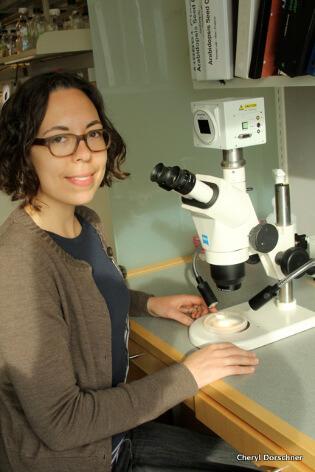When Emily Larson looks through a microscope at a petri dish full of seedlings, she sees the future of how plants might respond in nature to environmental stress. She looks for the slightest changes in the structures of cell walls and identifies which genes’ might be sensitive to those changes.
In a universe of just one standard petri dish she can grow at least 40 plants of Arabidopsis thaliana, so from its tiny seeds emerge a quick-growing, efficient model system for studying cell wall structure. Once they sprout roots, stems and leaves, she compares them to investigate, as she puts it, “proteins involved in vesicular trafficking pathways that are sensitive to changes in extracellular matrix organization, and how endocytosis as well as secretion may be involved in matrix metabolism.” She adds, “I investigate how these pathways function in the polarized root hair cells in the plant.”
Okay, distilled way down, Larson studies whether cell wall structure affects cell function, and how certain proteins in root hairs, for example, may serve different functions.
Her projects ask basic biological questions about how cells maintain their shape – which is really important for their function. These questions contribute to the overall dialogue about cellular responses and what's required for cell growth.
“And we are gaining a better understanding of how cells make and maintain particular cell wall structures that help the cell interface with its surroundings, which is important because plants have to respond to adverse changes in their environment even though they're stuck where they are. They must overcome potential environmental stress through cell growth, which means the cell must have ways to manipulate the cell wall architecture to allow for cell expansion,” Larson explains.
Wrapping Up Her UVM Work
Larson has worked in Professor Mary Tierney’s lab in Jeffords Hall on the University of Vermont campus since 2007. She is enrolled in UVM’s Cellular, Molecular and Biomedical (CMB) Sciences Graduate Program. Tierney’s lab is in the College of Agriculture and Life Sciences’ plant biology department and Tierney happens to be the current director of CMB – a cross-disciplinary program.
Larson finished her courses, and like all Ph.D. candidates, the next stages were to complete research, write and present her thesis and apply for post-doctoral positions before graduation in May. Normally, that would be a considerable juggling act. But Larson is the inaugural recipient of the Louise Raynor scholarship award.
“This provided Emily a semester of pure research,” observes Tierney. “Having the ability to focus on just her experiments and working on writing her thesis during the spring was invaluable.”
“At this level I don’t supervise Emily’s work, we are colleagues,” says Tierney with admiration. Tierney points out that Larson has already presented aspects of her research at three international conferences in the past three years and was an invited speaker at State University of New York-Potsdam biology lecture series in 2011.
Larson received her bachelor’s degree in biology from Bennington College. She worked in research labs at Massachusetts Institute of Technology and the University of Washington until she was accepted into UVM’s CMB Graduate Program.
“I chose to pursue my graduate degree at UVM because of the strong collaborative relationships among the faculty across the departments associated with the CMB Program, and the focus on fostering academic rigor and intellectual creativity in its students,” says Larson.
This summer, she'll continue in the Tierney lab, readying manuscripts for publication. And she'll design some curricula for undergraduate courses with UVM plant biology lecturers Laura Hill Birmingham and Laura Almstead.
In September she will join Professor Mike Blatt's lab at the University of Glasgow in Scotland to study vesicle and membrane transport in plants. Larson says she is confident that the cell biology and molecular biology approaches that she used at UVM are applicable in many fields. “I think the work I've done at UVM has helped me become a better scientist, I'm looking forward to using what I've learned here to be a strong and thoughtful member of my academic and social communities,” Larson says.
A charitable bequest from Louise Raynor’s estate established an endowed scholarship fund for graduate students in the College of Agriculture and Life Sciences’ department of plant biology. Raynor specialized in plant diversity and plant micro-technique courses in the University of Vermont botany department from 1946-1968. Her exquisitely prepared paraffin sections of a remarkable array of plants showing the beauty of plant interiors are still part of the department’s teaching collection. She retired as an associate professor. Raynor, 98, died in 2010.
“These scholarship funds have a special meaning for our College,” said Tom Vogelmann, dean of UVM’s College of Agriculture and Life Sciences. “I knew Dr. Raynor and feel very fortunate that they will continue to have a presence in the life of our students, even though they are no longer with us. They were superb teachers; the kind that brought out the best in their students. It is an honor to make scholarship awards in their names each year.” ~Howard Lincoln contributed to this story.
